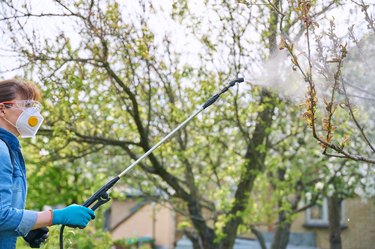
Although copper fungicide won't solve every garden issue, it is a great problem solver for many common plant issues. These include powdery mildew, downy mildew, black spot, rust, fire blight, and anthracnose. When you consider that fungi cause a very high percentage of plant diseases, the wisdom of understanding how to use copper fungicide becomes clear.
Understand Fungal Disease in Plants
Video of the Day
Like mold and mildew, fungi may be tiny as living organisms go, but they cause the vast majority of all plant diseases. That is, they are responsible for some 85 percent of all plant diseases on the planet. Over 100,000 species have been identified, although all but some 8 percent are benign. It is this small group that causes plant problems.
Video of the Day
It's not that these fungi intend to damage plants. The fact is that they need to feed on plants in order to live. They do not have chlorophyll, which means that they cannot photosynthesize and create their own food. Most fungi reproduce with lightweight spores that can be carried for miles on the wind or transferred by splashing water.
Common diseases that result from fungal infections include leaf spot, black spot on roses, gray leaf spot on turfgrass, fusarium wilt, canker rot and black root rot, verticillum wilt, anthracnose, soybean rust, and powdery mildew.
Understand Copper Sulfate
Copper fungicides are one of the top weapons in the fight against fungal diseases in plants. Almost all copper fungicides have a fixed copper as the active ingredient, with copper hydroxide, not copper sulfate, the most common. However, many use copper sulfate as well. Copper sulfate is a chemical that can kill algae, bacteria, and fungi. When it is mixed with calcium hydroxide, it is known as "Bordeaux mixture."
Copper is an important nutrient for plants as well as humans and most other organisms, but too much can be deadly. When you are talking about tiny organisms, like bacteria, mold, and fungi, it only takes trace amounts of copper to kill them. The copper can penetrate the membranes of these organisms to disrupt enzymes. This results in the organisms' death.
Use Copper Sulfate Fungicide
Using copper sulfate fungicide is no different than using any other copper fungicide. The basic rule is that you should always follow label directions for the best results. Also, put on long-sleeved clothing and wear gloves and eye protection. Prune off any branches with visible signs of disease before applying the fungicide.
Buy a ready-to-use product and spray it on in dry weather when you first perceive signs of fungal issues. If you are using a liquid concentrate product, you'll need to mix it with water before using it. To the extent possible, avoid getting the product on new growth since it lacks the waxy coating that develops over time and will be more easily injured. Reapply as necessary according to label directions.